FIsh was on sale and mom decided on a new project...Homemade salted fish! I must warn you, it does get a bit fishy smelling! It's a great time to do pickling and salting...Weather's warmed up and flies aren't out yet and as you can see, our three fish are hanging happily in the sun.
The old Chinese expression of living by salt fish and vegetables describe the folks with unable to buy fresh meats and produces and brings to mind of a simple life. It is usually associated with older folks, but it could be the preference for stronger flavour foods due to weakening taste buds or the desire to have food which reminds them of their yesteryear. For myself, while I tend not to eat it as a dish on it's own, I do enjoy 'salt-fish and chicken fried rice occasionally.
It is interesting to think about how different cultures preserve or eat their salt fish differently. The Portuguese has their codfish and then there's the ever versatile herring fish enjoyed differently by many European countries from raw, smoked or in a brine.
INGREDIENTS:
-cheap fish or whatever is on sale
-salt
DIRECTIONS:
1. Clean and wash fish thoroughly. Pat dry and drain.
2. Rub salt all over the fish and cavity.
3. Attach string to fish and hang outside in sun for about two days. It should be firm and dry in the end.
4. Wrap and store until ready to eat.
Traditionally, Chinese people don't eat a lot of sweets ( or cold dishes). However, some sweet dishes or special festive treats do exist though may take a bit of getting used to. Chinese steam or sponge cakes are a healthier option to the traditional buttery pound cake and seem to be readily accepted or liked whenever I bring these into the staff room for sharing. The Mooncake, a festive treat available annually during the Mid-Autumn Moon Festival can be a bit odd...I never thought about it before, but it was pointed out to me that a salted egg yolk tucked inside a dense mini-cake of sweet lotus or red bean paste seems a bit, well, unusual. After thinking about it, I have to say, this colleague did have a point.
Another commonly seen desert is the red-bean soup. This is often served for free at the end of meals at many of the Chinese restaurants. Another colleague pointed out that beans are vegetables and it's odd to think of it as a dessert. Another good point made. I didn't tell him that there a is a wide variety of sweet bean soups...green bean, barley...Not to mention tofu, yams corn and taro. I had the most delicious corn-flavoured pop-sickle while in Malaysia and numerous desserts featuring the ube (taro) in Japan. An acquired taste? Maybe, or maybe Asians are just genetically wired up to use beans and root vegetables in desserts.
Regardless, with the lower sugar content or the use of the natural sugars from the ingredients, Asian desserts are a healthier option. Often, nourishing ingredients are included to make it a health tonic as well.
Here's a common homemade sweet soup. If you use just four of the below ingredients, it's the Four Treasures Sweet Soup. If you use 6, it's the Six Treasures Sweet Soup.
I haven't figured out all the ingredients in English...It's a bit of a work-in-progress. Also, mom is one of those who eyeball things...A lot; and so it's tough to get accurate measurements from her. Thus, the combination of adjectives of handfuls, small bunch, cups and teaspoons. One day, maybe I will be as good as her and can eyeball measurements too.
INGREDIENTS:
1/2 C lotus seeds
10 wai shan (sliced)
1/4 C dried white lily pieces
1/5 C dried raw almond
10 red dates (optional - nourishes blood)
1/5 C Sze Sut (nourishes kidneys) optional
For Six Treasure Sweet Soup, add the following:
1/4 C sa sum
small handful Yuk Chuk
Rock sugar -quantity varies...The more you add, the sweeter it is.
DIRECTIONS:
1. Rinse ingredients to remove dust or dirt. Soak overnight (this is mainly for lotus seeds which require a long soaking time.)
2. When soften, use a small paring knife and split the lotus seed in half. Remove any of the green stems that may have sprouted within. These are bitter.
3. Bring a pot of water to boil. Add lotus seeds and bring to boil. Lower heat and simmer until lotus seeds are soft. About 10 minutes.
4. Add all ingredients except the white lily (this turns mushy if overcooked). Bring to boil and reduce heat. About 20 minutes.
5. Add white lily and rock sugar and slowly simmer for another 10 minutes or so. Serve hot.
Bamboo Girl #3 has just moved home and mom is cooking up a storm. There's pork belly marinating in the fridge and in a couple of days, it'll be ready for roasting. I'm looking forward to delightful CRUNCH of the pork skin!
BBQ pork, Roast pork, Roast duck, Soy sauce chicken are familiar sights in Chinese restaurants and in larger supermarkets. There are also numerous BBQ speciality shops as well and while all the gleaming roasted meats and birds on display may turn some away, the delicious aroma will definitely draw most people in.
While we usually buy our BBQ meat, mom sometimes get into a cooking mood and this is one of those times! INGREDIENTS:
-1 slab of pork belly (or two if you're hungry)
-5 spice, salt, sugar, soy sauce
DIRECTIONS:
1. Scrub the pork belly clean and pat dry with paper towel.
2. Rub a bit of soy sauce over the meat side of the pork belly. Then repeat witha mixture of 5-spice, salt and sugar. Leave the skin free of spice or soy sauce.
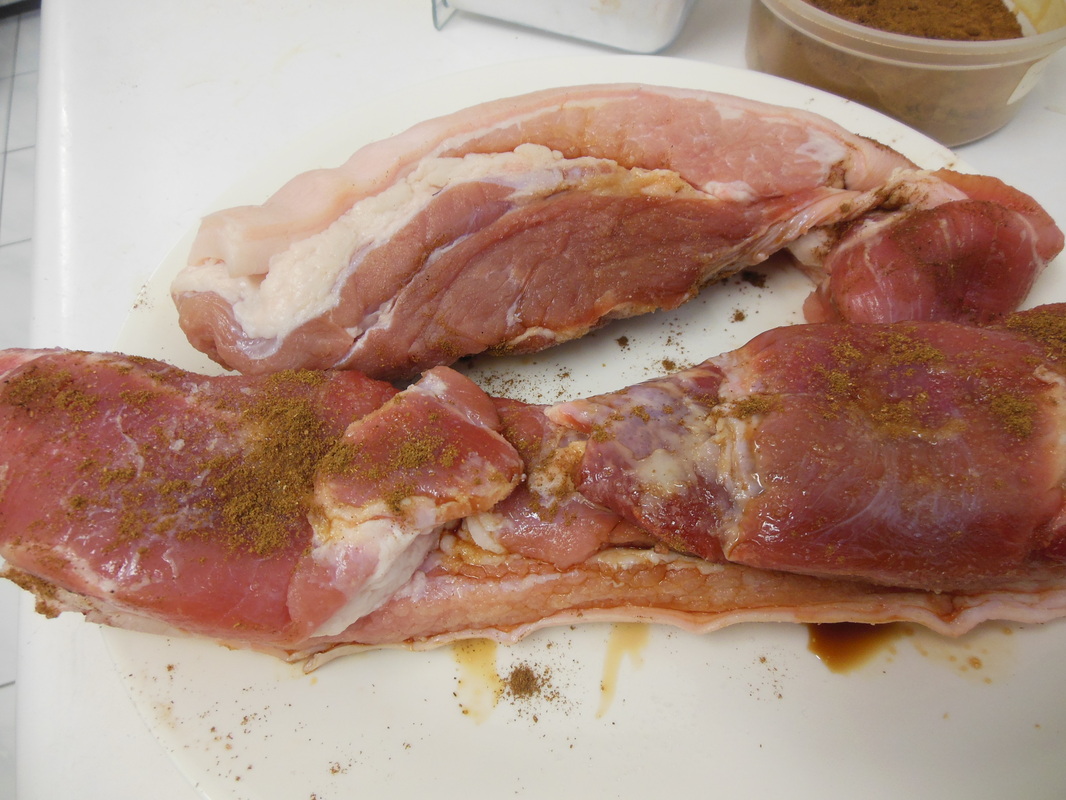
Rub a little soy sauce over the meat side of the pork belly. Then do the same with the spices.
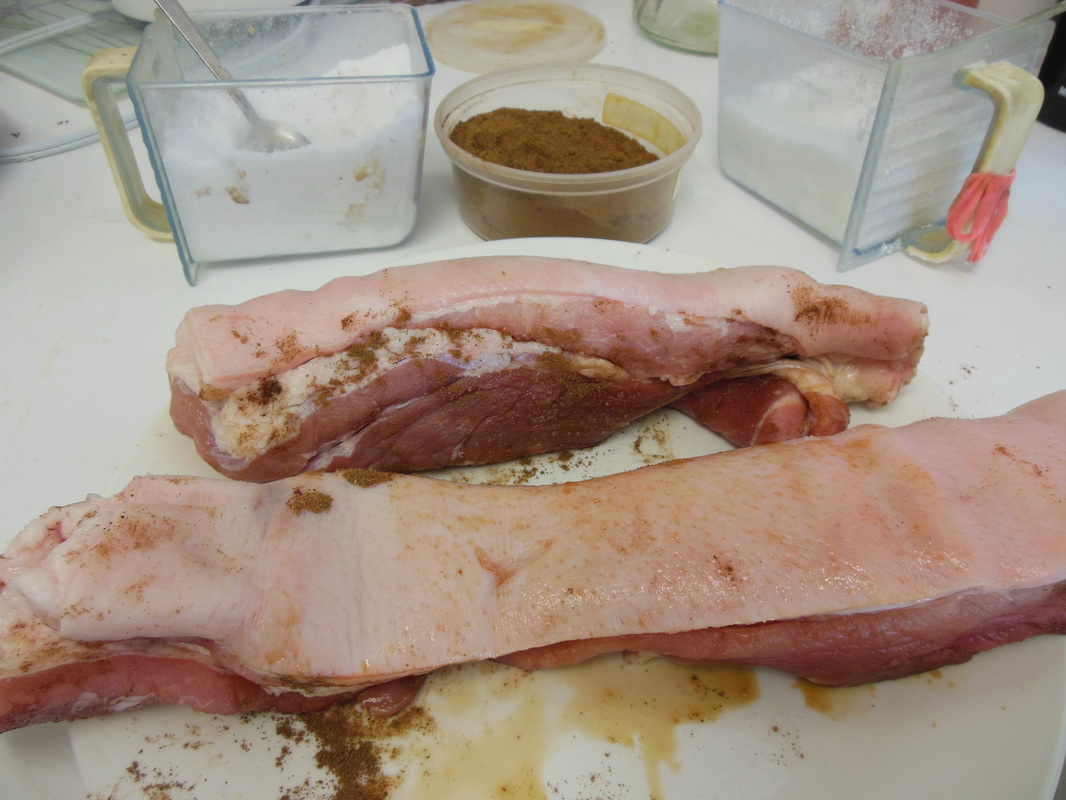
Ensure the skin is clean and dry so when roasted, it will extra crunchy!
3. Marinate in fridge uncovered for two days. You want the skin to dry out so that it will be crunchy and crispy when roasted.
4. When the pork skin is hard and dry to the touch, it is ready for roasting. Preheat oven to 350 degrees. Set pork belly skin-side down on a roasting rack...Do not let it sit in it's own juice or else the skin will not crackle.

After two days, the pork belly is dry enough for roasting.

Set skin side down on rack.
5. Roast for 30 - 40 minutes depending on thickness of cut. Meat can burn easily so do check every 15-20 minutes.
6. Flip over so it is skin-side up and broil for 10 minutes. Again, check regularly to prevent burning. The pork skin will turn to crackle.
7. Remove from heat and using a knife and fork, make a cut to check if meat is cut through. If not, flip pork belly onto side and roast for another 5-10 minutes. Do not put skin-side down anymore to ensure the skin crackle does not spoil.
8. Remove from heat and let cool completely before cutting and serving with mustard or Hoisin sweet sauce.
The nest is made from the saliva of a type of swallow's, the most expensive being the red nest. The soup made, also known as bird's nest soup is considered an expensive delicacy; prized for it's healthy and beauty enhancing properties.
Mom went a little crazy and got talked into making a large purchase...Let's just say it was it hit the four digit mark. With all three Bamboo Girls home, she was at a mothering instinct high...To ensure her girls radiate health and beauty.
The soup can be made savoury or sweet. My favourite is sweet and really think this is the best way to go. However, mom had some fresh chicken broth and decided to go savoury. You want to ensure all ingredients are as fresh as can be so as to not spoil the expensive nest.
INGREDIENTS:
5 pieces of bird's nest (more or less depending on how many you are feeding)
4C fresh chicken stock
DIRECTIONS:
1. Sock the desired amount of nest in water until soft. Pick out any loose feathers or dirt.
2. When soft, drain overnight.
3. Heat water in a double boiler.
4. Put the nest and chicken stock into a steaming pot and place in double-boiler.
5. Steam for 45mins - 1hour. The nest will take on a soft yellow colouring from the chicken broth and will float to top. To make sweet bird's nest soup, instead of using chicken stock, use water and add some Chinese rock sugar.
This posting is about organs, specifically duck kidneys so if you're squeamish about internal organs, you are warned!
Culture inspires me, religion invigorates me (as in a healthy, respectful debate) and languages interest me (admittedly, I have yet to master my own heritage language and the state of my French will leave my professeur in despair). And while religion and language are strong components of a culture, I would say nothing says culture more adepthly than food. It is also perhaps the easiest way to get introduced to a new culture. It's what I call a 3-D experience; you can smell it, taste it, feel it...And well, if it's alive before you gobble it, I suppose you can say you can hear it too?
Growing up in a Chinese family, I've had my fair share of what my non-Asian friends term as 'exotic' fare and I never fail to be amused by this. I suppose if you've been exposed to certain things from a young age, it doesn't strike you as unusual. And so, chicken feet, deep-fried sweet and sour intestines, braised kidneys, livers, stomach...I've had them and they're good! But, I am surprised that a few of my originally-from-Hong Kong friends are repulsed by this type of food. On the flip side, I do have a friend who eats pig brains and chicken testicles but I haven't worked up to that level yet.
Here are a few of the yummy dishes I mentioned above...Pics curtesy of Google. Mom says that about 30 years ago, wings ($0.25/lb), blue crabs ($0.25/lb), pork bones ($0.10/lb) and oxtails ($0.39/lb) were cheap! No one wanted chicken gizzards and were given away for free as with chicken feet from poultry farms. How silly, my mom thought of the non-Asians...All this good food and no one knows what to do with them. It's a different story now.
I am actually impressed that when an animal is slaughtered in an Asian market, generally, few parts are wasted...We're not going to get into sharks fin in this posting. That's a contentious one right now as Toronto considers a new ban on it. All I'm going to say is that while I'm a meat eater (I had a failed attempt at being a vegetarian), I don't believe in animal suffering and wastage. And now for my mom's duck kidneys. A family friend wanted to buy some dried duck kidneys for her watercress soup. At $28/lb, my mom said 'STOP'! She went to the supermarket at bought them fresh at $2.29/lb. Once dried, the 10lbs of fresh kidneys weighed in at 2.5lbs...And she spent only about $23.00! Moms are so economical! I wonder if they somehow magically become know-it-alls the minute they turn into a mom!
News of her dried duck kidneys travelled fast and for weeks after, we had racks and racks of drying duck kidneys. Below are two recipes, for dried duck kidneys and braised duck kideys in soy sauce.
Dried Duck Kidneys
INGREDIENTS:
-5lbs fresh duck kidneys yields approx. 1lb dried
-sea salt
-water
INSTRUCTIONS:
1. Rinse, clean and snip of fatty bits from kidneys. Put into bowl.
2. Pour sea salt over kidneys, mix well, set aside in friedge overnight.
3. Layer kidneys on drying rack and leave in sunny location for drying. At night, we put the trays near heat vents to speed up drying process.
(This would never work in Hong Kong; it's way to moist and it'll just get mouldy.)
4. Once dried, the kidneys take on a rich, deep burgundy hue. Pack in jar or plastic bag for future use.
TIP:
**Pick out small ones for braising as once dried, these become too small. See below for braising recipe.
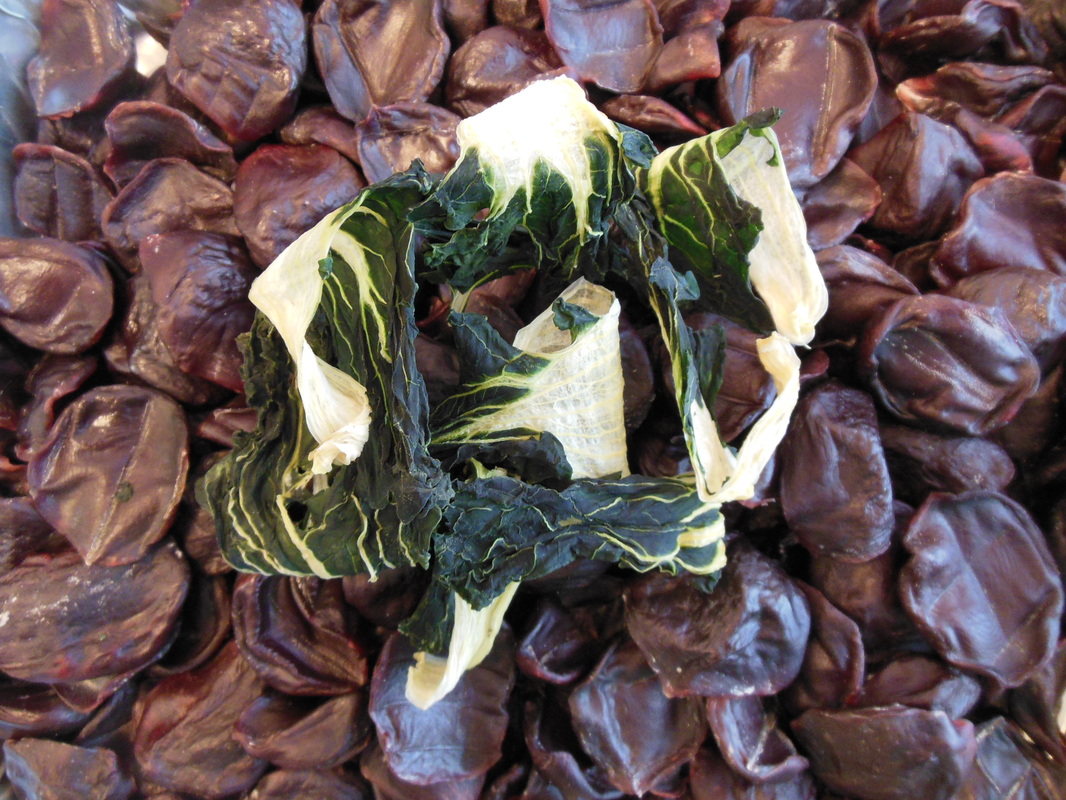 Ever the economical mom, she dries the older veggie leaves for making veggie soup. I included them here as a nice contrast to the dark red of the dried kidneys. Braised Duck Kidney in Soy Sauce:
Ingredients:
-duck kidneys
-Seasoning: soy sauce, rice wine, star anise, sliced ginger, sugar, sesame oil, a little water.
Instructions:
1. Rinse, clean and snip of fatty bits from duck kidneys. Drain and set aside.
2. Simmer in a pot, the seasoning ingredients. When it starts to bubble gently, lower temperature and add the kidneys.
3. Simmer for 15mins. Remove and garnish with scallions and/or coriander.
TIP:
**If there's a lot of seasoning sauce leftover, once cooled, pour into container and freeze for next use. You can use it to simmer pork tongue or hard-boiled eggs.
|
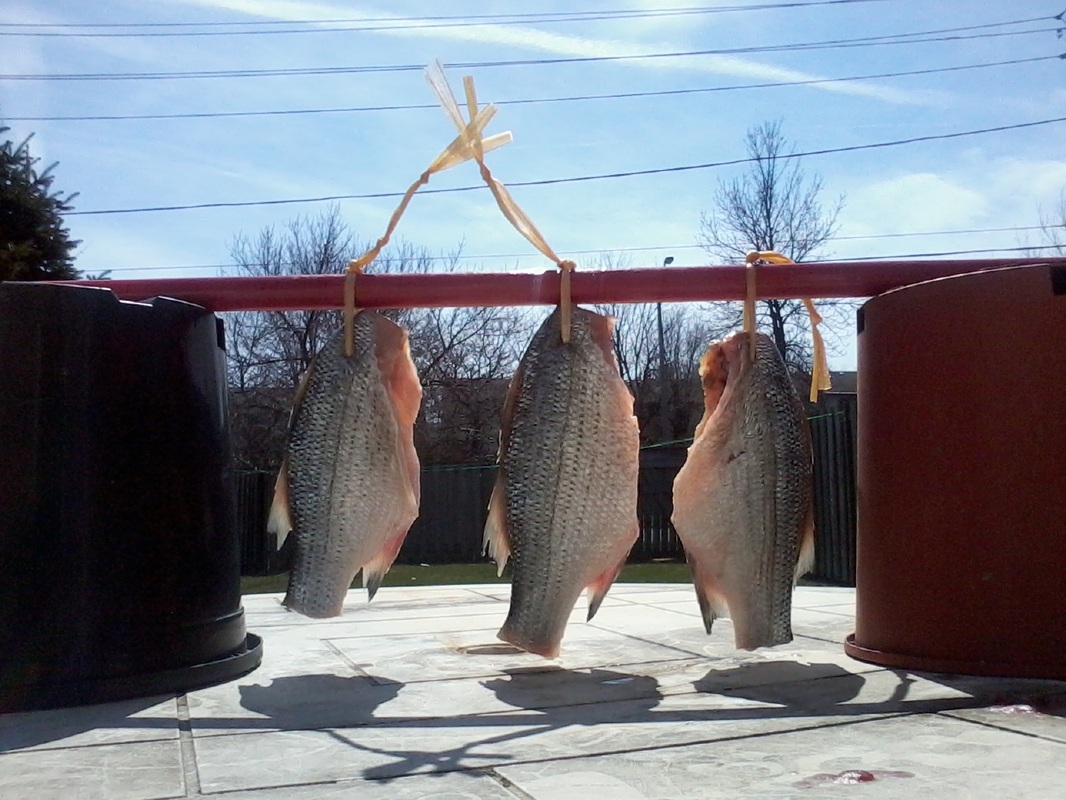




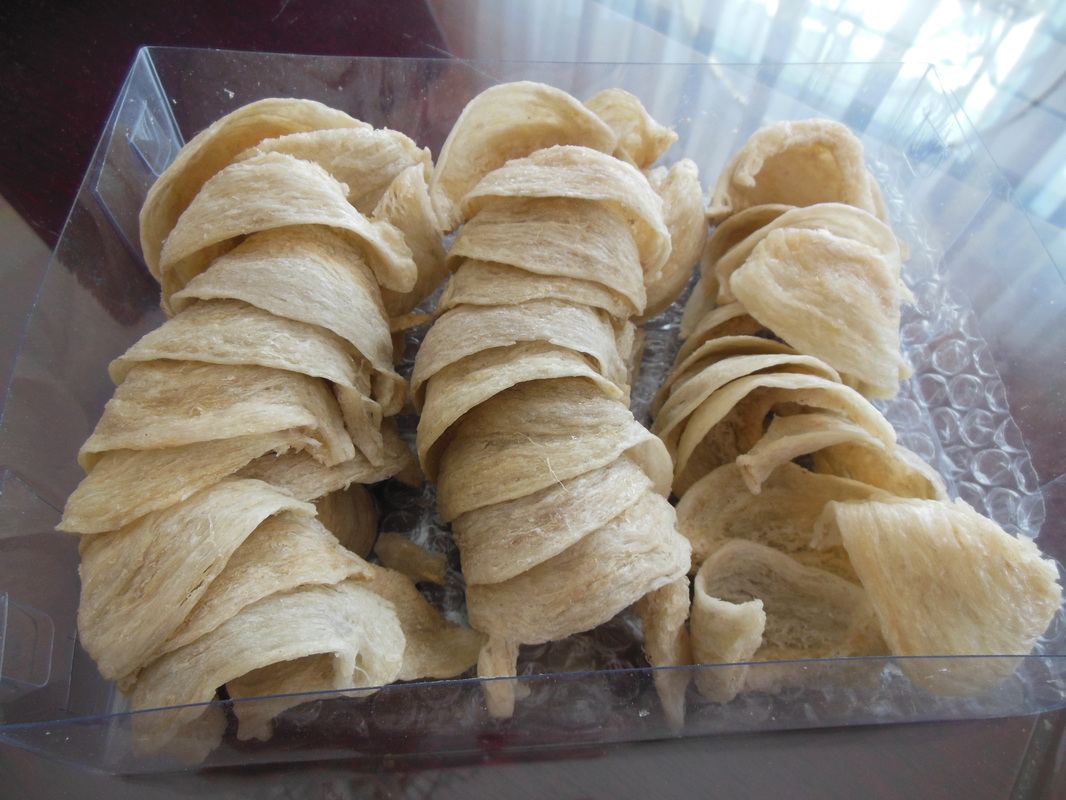


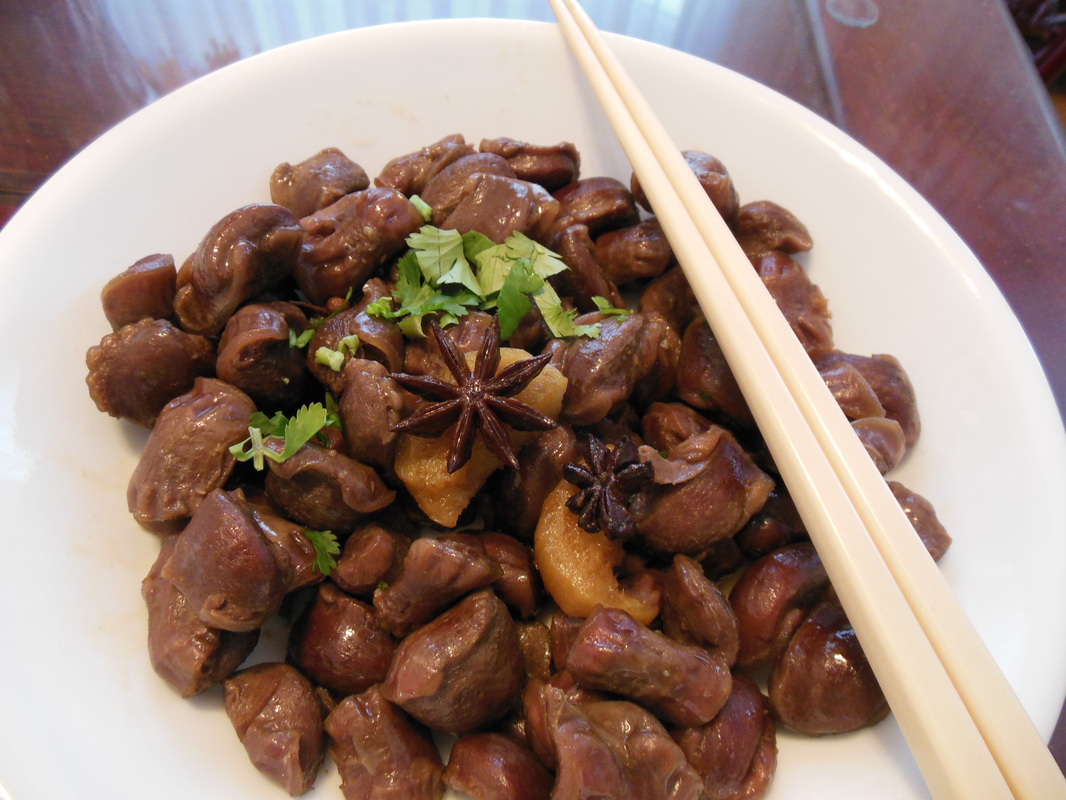
 RSS Feed
RSS Feed
